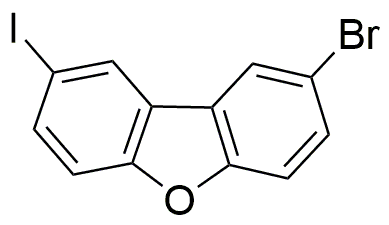2-Bromo-8-iododibenzofuran is widely utilized in research focused on:
- Organic Synthesis: This compound serves as a key intermediate in the synthesis of complex organic molecules, particularly in the development of pharmaceuticals and agrochemicals.
- Material Science: It is used in the creation of advanced materials, such as organic light-emitting diodes (OLEDs), due to its unique electronic properties.
- Biological Research: Researchers employ this compound in studies related to cellular processes and signaling pathways, helping to uncover mechanisms of disease.
- Photochemical Applications: Its ability to absorb light makes it valuable in photochemical reactions, which are essential in developing new energy solutions and photonic devices.
- Environmental Chemistry: The compound is investigated for its potential in environmental remediation processes, aiding in the breakdown of pollutants.
General Information
Properties
Safety and Regulations
Applications
2-Bromo-8-iododibenzofuran is widely utilized in research focused on:
- Organic Synthesis: This compound serves as a key intermediate in the synthesis of complex organic molecules, particularly in the development of pharmaceuticals and agrochemicals.
- Material Science: It is used in the creation of advanced materials, such as organic light-emitting diodes (OLEDs), due to its unique electronic properties.
- Biological Research: Researchers employ this compound in studies related to cellular processes and signaling pathways, helping to uncover mechanisms of disease.
- Photochemical Applications: Its ability to absorb light makes it valuable in photochemical reactions, which are essential in developing new energy solutions and photonic devices.
- Environmental Chemistry: The compound is investigated for its potential in environmental remediation processes, aiding in the breakdown of pollutants.
Documents
Safety Data Sheets (SDS)
The SDS provides comprehensive safety information on handling, storage, and disposal of the product.
Product Specification (PS)
The PS provides a comprehensive breakdown of the product’s properties, including chemical composition, physical state, purity, and storage requirements. It also details acceptable quality ranges and the product's intended applications.
Certificates of Analysis (COA)
Search for Certificates of Analysis (COA) by entering the products Lot Number. Lot and Batch Numbers can be found on a product’s label following the words ‘Lot’ or ‘Batch’.
Número de catálogo
Número de lote/lote
Certificates Of Origin (COO)
This COO confirms the country where the product was manufactured, and also details the materials and components used in it and whether it is derived from natural, synthetic, or other specific sources. This certificate may be required for customs, trade, and regulatory compliance.
Número de catálogo
Número de lote/lote
Safety Data Sheets (SDS)
The SDS provides comprehensive safety information on handling, storage, and disposal of the product.
DownloadProduct Specification (PS)
The PS provides a comprehensive breakdown of the product’s properties, including chemical composition, physical state, purity, and storage requirements. It also details acceptable quality ranges and the product's intended applications.
DownloadCertificates of Analysis (COA)
Search for Certificates of Analysis (COA) by entering the products Lot Number. Lot and Batch Numbers can be found on a product’s label following the words ‘Lot’ or ‘Batch’.
Número de catálogo
Número de lote/lote
Certificates Of Origin (COO)
This COO confirms the country where the product was manufactured, and also details the materials and components used in it and whether it is derived from natural, synthetic, or other specific sources. This certificate may be required for customs, trade, and regulatory compliance.


